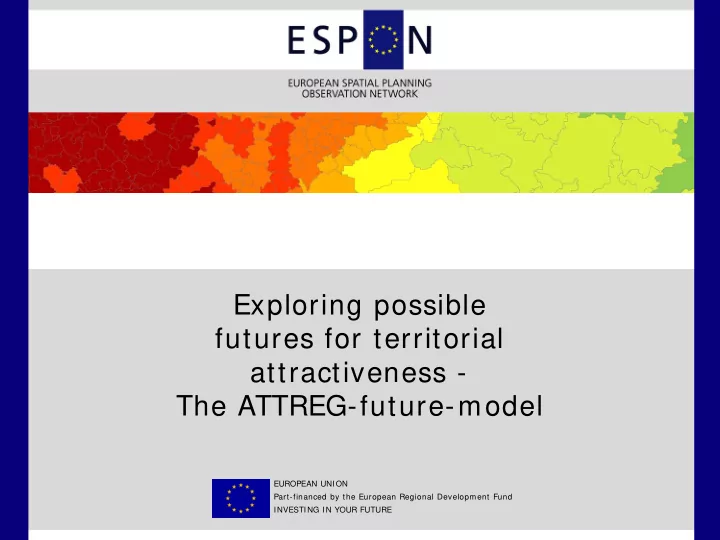

Exploring possible futures for territorial attractiveness - The ATTREG-future-model EUROPEAN UNION Part-financed by the European Regional Development Fund INVESTING IN YOUR FUTURE
Background WIOD-project – applications within regional modeling at • the European level The ESPON-ATTREG-project= The Attractiveness of • European regions and cities for residents and visitors – Econometric analysis: • Dep. var.: Mobility (migration & tourism) • Indep. var.: Territorial capital • Regional unit: NUTS-2 (EU) & LAU-1 (DK & Slovenia) – Case studies – ”outlier regions” – ATTREG-future model which is used for forecast and scenario analysis Synthesis: How to (in the future) include IO in regional • demographic models?
Outline • Mobility (dep.) – Capital (in-dep.) • The ATTREG-future model • The DEMIFER and the ATTREG-future scenarios • Scenarios include multiplier experiments with the ATTREG-future-model • The ATTREG-future model with a regional IO (WIOD)-core: How to include the interaction between demography and economic development into environmental modelling at the regional level.
Mobility and territorial capital ATTREG-project • Econometric analysis: – Dep. var.: Mobility (migration & tourism) • 15-24 year / 25-49 year / 50-64 year • Domestic / Foreign tourism – Indep. var.: Territorial capital • ”Antropic capital” • ”Economic and Human capital”-variables • ”Environmental capital” • ”Institutional capital” • ”Social and Cultural capital” – Regional units: NUTS-2 (EU) & LAU-1 (DK & Slovenia)
A P # Monum. & Net Migration tour. sights migration From / to P A Rank Air rate Out- Passenger migr. Death A P Tourism acc. In- beds migr. A Acces- Born sibility Metrop. In Area NUTS 2 reg. A N Pop Tert.educ. In Dens. A E P work force E Cons.empl. GDP per A : Antropic capital E N share capita E : Economic and Human capital Varm - cold N N N : Environmental capital S N Natura I : Institutional capital P N 2000 sites Pop 65+ / N S : Social and Cultural Capital workage pop S Coastal P : Policy Instruments N N regions Satisfied – P N : Non-policy instruments in generel S Exogenous Islands N N Univ. Stud. / N attraction factors pop 15-24 I P I P I Satisfied - Endogenous or cumulative health Publ. Cons. #NUTS 2 in attraction factors Empl. Country
Mobility and territorial capital Econometric results • Please see the paper (and related papers/ ESPON-reports) • Expected signs • … … . • Then: How to include the demographic core into the ATTREG-future model
ATTREG-future m odel Causal structure • 2 simultanous blocks: – Migration – Population - Attractions – Population – Labour force - employment – Income/ capita - trade • Direct effects from attractions • Derived effects from attractions should add impacts from the 2 simultanous blocks with a number of iterations • ”Double multipliers” • See equations in the paper 8
The ATTREG-future m odel and scenarios w ith the ATTREG-future m odel ATTREG-future model is an extended demographic model • Scenarios with the ATTREG-future-model: • – 1 reference scenarios (Forecast to 2025) • Unchanged migration pattern • Trends in productivity • Etc. – 3 policy packages / multiplier experiments • Smart policy • Sustainable policy • Inclusive policy – Applied for 2 clusters • Objective 1 regions • Overheating regions (“population congested regions”)
Selection of policy package instruments
Selection of policy package instruments
Selection of policy package instruments
The ATTREG-future m odel Scenario/ Multiplier results Direct effects in the ”policy region” (= Object 1 regions) • – Depend on the sign of direct effects – Assume positive in-migration Where does in-migration originate? • – Derived negative effects on surrounding regions (within country) Derived effects • – Conventional multiplier effects (positive) – Real Exchange rate / export job effects (negative / positive) • Short run – might be negative • Long run – normally positive
Results of Multiplier experim ent: ratio of the number of university students against people aged 15 to 24 years increases with + 0.10 New in-migration almost constant per year • Accumulated in-migration growing through years • Out-migration from other regions growing (negative in-migration) • Population increases/ decreases with the • – Initial increase (2010) – Accumulated in-migration (2020 and 2030) Labor force and employment by place of residence increase • – not very much the first years (2010) (low labor participation rates for young) – more the following years (2020 and 2030) the older the in-migrants become (higher labor participation rates) Population dependent jobs increase • – More the first years (2010) – Less the following years (2020 and 2030) Export jobs • – Decrease the first years (2010) – Increase the following years (2020 and 2030) GDP per capita • – Decreases the first years (2010) – Increases the following year (2020 and 2030)
Integrating economic model (IO) into the extended demographic model (ATTREG-future) • Demographic and economic development • How to capture commodity market effects (economic financial and depth crisis)? • How to capture population changes in economic models (in- / out-migration)? • Impacts on the environment
USE- Interregiona matrices l trade Supply- matrices
2 by 2 by 2-principle model Place of Commodity production market (P) place (S) Sector PRODU- x (J) CERS B D Commo dities Arbejds f T Marked (I) x=DTBx+DTf Make-Use x= (I-DTB) -1 DTf Approach x=(I+DTB 1 + DTB 2 + DTB 3 + … .)DTf instead of x= Ax+ f Institutional x=(I-A) -1 f Approach x= (I+ A 1 + A 2 + A 3 + … .)f
Recommend
More recommend